RESEARCH
Cost-effectiveness of oral cancer screening: results from a cluster randomized controlled trial in India
Rapport coût-efficacité du dépistage du cancer buccal: résultats d'un essai contrôlé randomisé en grappes en Inde
Costoeficacia del cribado del cáncer de boca: resultados de un ensayo aleatorizado controlado por conglomerados en la India
Sujha SubramanianI, *; Rengaswamy SankaranarayananII; Bela BapatI; Thara SomanathanIII; Gigi ThomasIV; Babu MathewV; Jissa VinodaV; Kunnambath RamadasII
IRTI International, 1440 Main Street, Waltham, Massachusetts, MA, 02451-1623, United States of America
IIInternational Agency for Research on Cancer, Lyon, France
IIIDivision of Cytopathology, Regional Cancer Centre, Trivandrum, India
IVDivision of Community Oncology, Regional Cancer Centre, Trivandrum, India
VTrivandrum Oral Cancer Screening Project, Regional Cancer Centre, Trivandrum, India
ABSTRACT
OBJECTIVE: To evaluate oral cancer screening by visual inspection.
METHODS: A cluster randomized controlled trial was initiated in Trivandrum district, Kerala, India. Of 13 population clusters, seven were randomly allocated to three rounds of screening between 1996 and 2004, while standard care was provided in six (control arm). An activity-based approach was employed to calculate costs associated with various components of the screening trial. Information on the resources used and on clinical events in each trial arm was derived from trial databases. Total costs for each cluster were estimated in 2004 United States dollars (US$). The incremental cost per life-year saved was calculated for all eligible individuals and for high-risk individuals (i.e. tobacco or alcohol users).
FINDINGS: The proportion of oral cancers detected at an early stage (i.e. stage I or II) was higher in the intervention arm than the control arm (42% versus 24%, respectively). The incremental cost per life-year saved was US$ 835 for all individuals eligible for screening and US$ 156 for high-risk individuals. Oral cancer screening by visual inspection was performed for under US$ 6 per person.
CONCLUSION: The most cost-effective approach to oral cancer screening by visual inspection is to offer it to the high-risk population. Targeted screening of this group will ensure that screening can be offered at a reasonable cost in a limited-resource setting.
RÉSUMÉ
OBJECTIF: Evaluer le dépistage du cancer buccal par examen visuel.
MÉTHODES: Un essai contrôlé randomisé en grappes a été lancé dans le district de Trivandrum, dans l'Etat du Kerala, en Inde. Parmi les 13 grappes de population, 7 avaient été affectées aléatoirement à trois tournées de dépistage entre 1996 et 2004, tandis que les 6 autres (bras témoins) recevaient des soins standard. Les coûts associés aux différentes composantes de l'essai de dépistage ont été calculés en procédant par activités. Des informations sur les ressources utilisées et les événements cliniques dans chaque bras de l'essai ont été tirées de bases de données d'essai. Le coût total pour chaque grappe a été estimé en dollars des Etats-Unis d'Amérique (US $) de 2004. Le coût marginal par année de vie épargnée a été calculé pour tous les individus admissibles dans l'étude et pour ceux à haut risque (c.-à-d. les consommateurs de tabac et d'alcool).
RÉSULTATS: La proportion de cancers buccaux détectés à un stade précoce (c.-à-d. au stade I ou II) était plus élevée dans le bras d'intervention que dans le bras témoin (42 % contre 24 % respectivement). Le coût marginal par année de vie épargnée était de US $ 835 pour l'ensemble des individus admissibles dans l'étude et de US $ 156 pour les individus à haut risque. Le dépistage du cancer buccal par examen visuel a été pratiqué pour un coût inférieur à US $ 6 par personne.
CONCLUSION: La démarche la plus efficace sur le plan économique pour dépister le cancer buccal par examen visuel consiste à proposer cet examen à la population à haut risque. Le dépistage ciblé de ce groupe garantit la possibilité de proposer ce dépistage à un coût raisonnable dans un pays à ressources limitées.
RESUMEN
OBJETIVO: Evaluar el cribado del cáncer de boca mediante inspección visual.
MÉTODOS: Se llevó a cabo un ensayo controlado aleatorizado por conglomerados en el distrito de Trivandrum, Kerala, India. De 13 conglomerados de población, siete se asignaron aleatoriamente a tres rondas de cribado realizadas entre 1996 y 2004, y en los otros seis se ofreció la atención habitual (grupo control). Se empleó un método basado en la actividad para calcular los costos asociados a diversos componentes del ensayo de cribado. La información relativa a los recursos empleados y los eventos clínicos en cada grupo de ensayo se extrajo de la base de datos correspondiente. Los costos totales para cada conglomerado se estimaron en dólares de los Estados Unidos (US$) de 2004. Se calculó el costo marginal por año de vida ganado para todas las personas elegibles y para las personas de alto riesgo (es decir, consumidores de tabaco o alcohol).
RESULTADOS: La proporción de cánceres de boca detectados en un estadio inicial (es decir, estadio I o II) fue mayor en el grupo de intervención que en el grupo de control (42% frente a 24%, respectivamente). El costo marginal por año de vida ganado fue de US$ 835 para todas las personas elegibles para el cribado, y de US$ 156 para las personas de alto riesgo. El cribado mediante inspección visual costó menos de US$ 6 por persona.
CONCLUSIÓN: La opción más costoeficaz para cribar el cáncer de boca mediante inspección visual consiste en ofrecer el tamizaje a la población de alto riesgo. El cribado focalizado de tales grupos garantiza que ese tipo de examen se pueda ofrecer a un costo razonable en los entornos con recursos limitados.
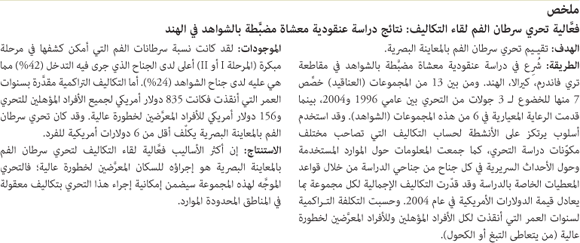
Introduction
Oral cancer is a major health problem in certain parts of the world. Globally, there are around 270 000 new cases annually and 145 000 deaths, of which two-thirds occur in developing countries.1 The Indian subcontinent accounts for one-third of the world burden. Oral cancer is the most common form of cancer and accounts for much cancer-related death among men in India. The main risk factors for developing oral cancer are tobacco and alcohol use.2,3 The detection of small, early-stage oral cancer has been shown to lead to significantly reduced mortality and morbidity.4
Low- and middle-income countries have limited health-care resources available for cancer screening and it is therefore critical that costs and benefits are assessed and that the most cost-effective approach is identified. The cost-effectiveness analyses of oral cancer screening performed to date have provided estimates for high-income countries that are not generalizable to settings where resources are limited.5,6 In addition, these studies have used decision-analysis models in which there was considerable uncertainty in parameter values. For instance, no reliable data are available on the malignant transformation rate or on disease progression. The results obtained using these models may, therefore, not be accurate and many authors acknowledge the need for additional clinical studies to provide better estimates of the parameters used.6
In this study, the cost-effectiveness of visual inspection in oral cancer screening in a limited-resource setting was determined using data from a randomized controlled trial performed in a number of population clusters in the Trivandrum district of Kerala in southern India. The screening trial was initiated in 1996 and results for the 9-year period up to 2004 have been published previously.7 Of the 13 clusters (i.e. panchayaths or municipal administrative units) included in the study, seven were randomly allocated to take part in three rounds of oral visual inspection by trained health-care workers, while six received standard care and educational messages and served as a control arm. All healthy individuals aged 35 years and older were eligible for inclusion in the study. Visual screening was performed by university graduates in non-medical subjects. These individuals received training on how to perform oral visual inspections, how to identify lesions that could be precancerous and how to detect oral cancer. A previous study had shown that the sensitivity and specificity of oral visual inspection by health-care workers were 94.3% and 99.3%, respectively, and that there was a very high level of agreement between the findings of health-care workers and physicians.8
Results for the time after the initial 9-year trial period (i.e. 1996-2004) are not yet available and we have, therefore, limited the cost-effectiveness analysis to the period covered by the trial. The results of comparisons between intervention and control arms are reported in terms of the number of oral cancers detected and the number of life-years saved by screening. We estimated the costs of the screening programme (for example, for recruiting health-care workers and screening individuals), of diagnosing and treating the oral cancers detected, and of research activities. In addition, we estimated the cost from a societal perspective by including the cost to the patient of the time spent undergoing diagnosis and treatment. It is important that social costs are assessed, since the true burden of screening goes beyond that associated with the health-care system and should include, for instance, loss of income during the time spent undergoing screening.
Methods
The design of the cluster randomized controlled trial, the visual screening method used, compliance with screening, and cancer detection and mortality rates have been described in detail elsewhere.7 The study protocol was reviewed and approved by the scientific and ethics review committees of the Regional Cancer Centre, Trivandrum, India, and the International Agency for Research on Cancer, Lyon, France. Information on participant demographics, screening performed and the number of events in each study arm was obtained from the clinical trial database. A high-risk individual was defined as one who used either alcohol or tobacco or both.
An activity-based approach was used to calculate the costs associated with the various components of the programme.9 Activity-based costs are derived by assigning the costs of the resources used to specific activities involved in implementing the screening programme. These programme activities included recruitment or invitation of screening participants, screening, data collection, research, and management and administration. Data on all the resources used were obtained from the financial database maintained by the screening programme. Details of the staff employed by the programme and of the equipment and supplies purchased were also obtained from the database. The costs of staffing, equipment, consumables and travel were allocated to key programme activities on the basis of the expenditure incurred for each activity. The accuracy of the cost allocations made was verified by consulting financial records and programme staff. Indirect costs and the costs of overheads for programme activities were also obtained so that the total cost could be accurately determined. In addition, the costs of biopsies and treatment were derived from the information contained in the programme financial database and hospital records at the Regional Cancer Centre in Trivandrum, where the majority of patients were treated. The costs incurred for diagnostic tests and treatment were determined for participants who underwent procedures at the Regional Cancer Centre. For those who were treated elsewhere, the cost of a procedure was estimated by using an average cost for each treatment stage, which was obtained from the Regional Cancer Centre. All costs are reported in 2004 United States dollars (US$).10
Although the screening programme was embedded within a clinical trial, many of the costs incurred are relevant for implementing similar programmes in the real world. For instance, the costs of training, recruitment and screening are all essential components of any programme. Costs will also be incurred for data collection, although data requirements will probably be less burdensome outside of the context of a screening trial. The costs of research activities were directly related to the clinical trial and we have therefore reported those costs separately. The cost of a patient's time was estimated from the time spent undergoing diagnostic tests and receiving treatment. We used an average daily wage of 200 Indian rupees (approximately US$ 5.00) to estimate the wages lost. This estimate was based on information provided by programme staff on the earnings of male workers in both formal and informal sectors of the economy. We used the wage rate for men, even though women generally tend to earn less than men in India,11 because there was a disproportionately larger number of men in the high-risk group and men were more likely to undergo diagnostic tests and treatment for oral cancer. We did not include the cost of any wages lost while undergoing screening because screening was carried out in a community setting and there was a minimal impact, if any, on work schedules.
We report the cost of the programme separately for each programme activity for both intervention and control arms. In addition, we also report the cost of the programme per person. This latter cost takes into account the different numbers of individuals involved in the two arms of the trial. The average cost per 100 000 individuals in both intervention and control arms was calculated, and the incremental cost of the intervention was derived by comparing the two figures.
The effectiveness of screening was assessed using the number of cancers detected in the individuals eligible for screening in each arm of the trial to derive an estimate of the number of life-years saved based on the mortality rate reported during the 9-year period of the clinical trial. The number of life-years saved was estimated by assuming that, on average, an individual would die from cancer at the age of 50 years (i.e. the mean age of individuals in both intervention and control arms). The life expectancy of the population enrolled in the clinical trial was 73.5 years, which is the average estimated lifespan reported for the state of Kerala, where screening was performed.12
The incremental (i.e. the difference between intervention and control arms) cost per oral cancer detected and the incremental cost per life-year saved are reported for both the general population and the high-risk group of tobacco or alcohol users. Neither the cost nor the effectiveness measure was discounted, since only the results obtained during the clinical trial were reported and no modelling of the lifetime impact was carried out. Nonparametric bootstrapping was performed to generate 95% confidence intervals (95% CIs) to assess the uncertainty in the cost-effectiveness ratios obtained and also to test the sensitivity of the results to changes in unit costs.
Results
Table 1 shows the details of the demographic characteristics and screening history of individuals in the intervention and control arms according to whether or not they were tobacco or alcohol users, the number and stage of oral cancers detected, and the number of resulting deaths. In total, 87 829 of the 96 517 (91%) eligible individuals in the intervention arm were interviewed, and 80 086 of the 95 356 (84%) eligible individuals in the control arm received educational messages. About 40% of both arms were male, and participants were on average 49 years old. A large proportion of the men interviewed were at a high risk of developing oral cancer: 73% in the intervention arm and 67% in the control arm. In contrast, a much smaller proportion of the women were identified as being at a high risk: 27% and 21% in the two arms, respectively. Smoking was the most common high-risk habit among men, while women were most likely to use chewing tobacco. Overall, 85% of those who had a chewing habit chewed betel quid (i.e. betel leaves with lime and areca nut) with tobacco, about 9% chewed betel quid without tobacco, and the remainder chewed paan masala.
Almost all (90%) of the eligible individuals in the intervention arm were screened at least once, and 30% underwent three rounds of screening. Among those who underwent screening, 6% had referable lesions, and 63% of those with lesions complied with recommendations and underwent diagnostic testing. Over the course of the trial, 205 newly diagnosed cancers were detected in the intervention arm compared with 158 in the control arm. The majority of cancers (95%) were found in high-risk individuals. A greater proportion of cancers were detected at an early stage (i.e. stage I or II) in the intervention arm than in the control arm (41% versus 24%, respectively). There were 77 deaths in the intervention arm and 87 in the control arm.
Table 2 lists the total cost of the screening programme and the costs of specific programme activities, research and diagnosis, and patients' costs in the intervention and control arms. Around 75% of the costs were related to staff expenditure. Other areas of significant expenditure were equipment and travel, at around 7% each. The total cost for the intervention arm was US$ 478 742, compared with US$ 260 351 for the control arm. Recruitment or invitation costs of US$ 57 254 were incurred in both arms and accounted for 12.0% and 22.0% of the total cost for the intervention and control arms, respectively. The cost of performing visual screening was US$ 53 987, with 64.6% of this cost related to staff and 27.3% related to purchasing consumables, including tongue depressors and disposable gloves. Overall, 60.0% of the cost incurred in the intervention arm was for programme activities (i.e. recruitment or invitation, screening, data collection, and management and administration) and research activities. In the control arm, 77.2% of the cost was incurred for these activities. The cost of diagnostic testing was much greater in the intervention arm than in the control arm, at US$ 94 969 versus US$ 1651, respectively. In addition, the cost of the wages lost by patients while undergoing diagnostic procedures and treatment was higher in the intervention arm than in the control arm.
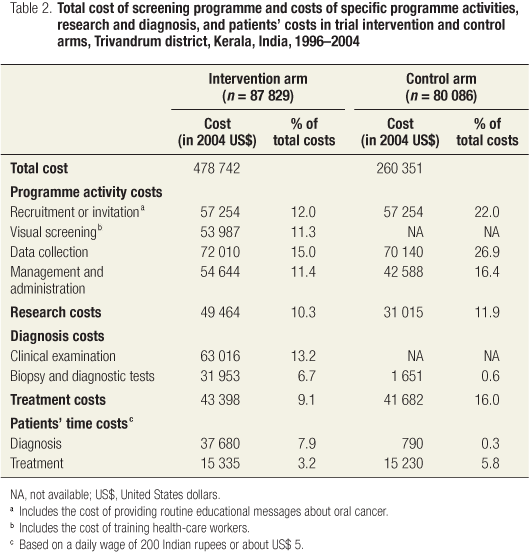
Table 3 shows the total cost per person after adjusting for the number of individuals enrolled in each arm of the trial and the cost per person of the different components of the trial. The total cost per person was US$ 5.56 in the intervention arm and US$ 3.31 in the control arm. Almost half (48.7%) of the per person cost in the intervention arm was for programme-related activities, 19.4% was for diagnostic testing and approximately 10% each was for research, treatment and patients' time. The breakdown of the per person costs in the control arm was 64.0% for programme activities, 17.5% for treatment, 11.8% for research and 6.0% for the patients' time.
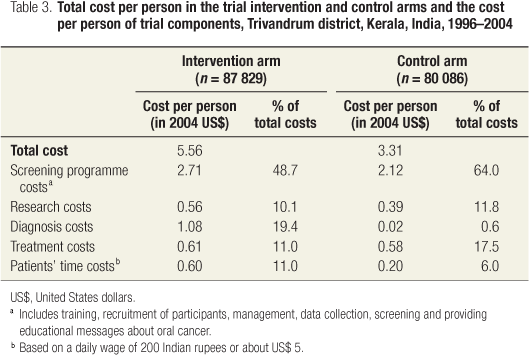
Table 4 summarizes the total cost and the effectiveness of screening per 100 000 eligible individuals, as well as the incremental cost-effectiveness ratios for screening in terms of the cost per additional cancer detected and the cost per life-year saved. The screening programme resulted in the identification of an additional 46.70 oral cancers per 100 000 members of the general population aged 35 years or more who were eligible for screening and an additional 23.95 cases per 100 000 high-risk individuals who were eligible for screening. This was associated with 269.31 life-years saved per 100 000 individuals in the general population and 1437.64 life-years saved per 100 000 high-risk individuals, since the difference in oral cancer mortality between the trial arms was much greater for high-risk individuals. The incremental cost per oral cancer detected was US$ 4817 for all individuals and US$ 9394 for high-risk individuals. The incremental cost per life-year saved was US$ 835 for all individuals and US$ 156 for high-risk individuals.
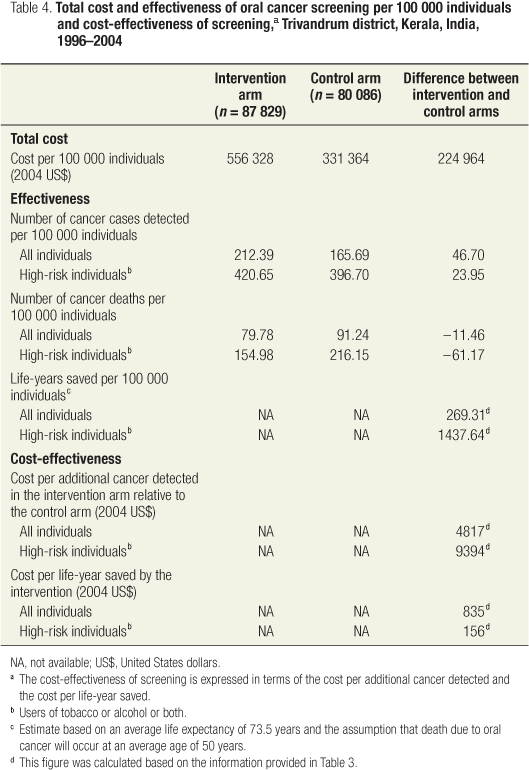
Fig. 1 shows the variation in the total cost of oral cancer screening per 100 000 individuals with the number of cases detected per 100 000 individuals, as derived by a simulation that used nonparametric bootstrapping and data from each of the intervention and control clusters. The 95% CI for the cost per oral cancer detected, as derived using nonparametric bootstrapping, was US$ 2003 to US$ 11 038. The sensitivity analysis showed that variations in unit costs did not result in significant changes in cost differences between the control and intervention arms.
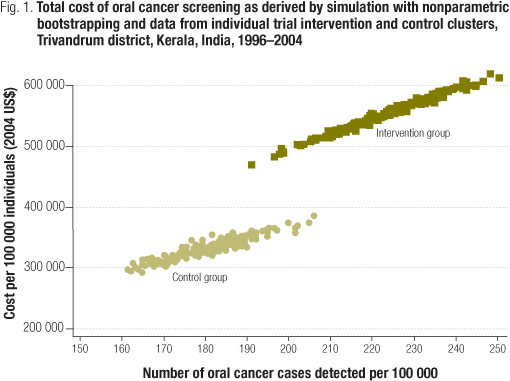
Discussion
This study shows that using visual inspection for oral cancer screening was cost-effective in southern India and could be performed for under US$ 6 per person eligible for screening over the course of a 9-year screening programme, even when the total cost included the cost of operating the programme and the cost of diagnostic tests, the treatment required and the associated patients' time. Our analysis differs from previous economic assessments in that our cost estimates are based on the costs actually incurred in implementing and operating a screening programme and not on those generated by decision-analysis models, which often involve numerous assumptions. We have reported the costs of the components of the programme and treatment in detail. In addition, we have also estimated the programme's societal impact by quantifying the costs associated with the patients' time. Therefore, this study provides in-depth information that can assist policy-makers and programme managers in planning and implementing an oral cancer screening programme.
The sensitivity analysis of the effect of varying input cost estimates indicates that the incremental cost-effectiveness ratios obtained in the study are generally robust. Currently, there are no standard criteria for a cost-effectiveness ratio threshold below which an intervention is considered cost-effective. We used the criteria of the WHO Commission on Macroeconomics and Health, which define an intervention as being very cost-effective when its cost-effectiveness ratio (generally expressed in terms of the cost per disability-adjusted life-year, quality-adjusted life-year or life-year saved) is below a country's gross domestic product (GDP) per capita.13 In this study, the incremental cost per life-year saved was less than US$ 850, which is considered very cost-effective given that the GDP per capita for India in 2004 was US$ 2900.
Nevertheless, even when an intervention is highly cost-effective, the funding required to implement it may not be available when resources are limited. In our study, over 90% of the cancer cases detected, and the subsequent deaths, occurred in the high-risk group of tobacco or alcohol users. The results of the trial show that screening identified more additional oral cancers per 100 000 members of the general population than per 100 000 high-risk individuals, but also that high-risk individuals were more likely to die from their cancers. High-risk individuals, therefore, bear a greater disease burden and screening can reduce the high mortality rate from oral cancer in this group. The most cost-effective approach, as indicated by the cost per life-year saved, is to establish a screening programme for tobacco and alcohol users aged 35 years and above. We recommend a predominantly horizontal programme (i.e. one embedded in the existing health-care system) with vertical inputs in training, programme evaluation and investment in health-care infrastructure to enable screening to be offered at a reasonable cost. Visual screening could take place once every 3 years, as in our study, and could be performed in primary care by doctors, nurses or health-care workers.
The annual per capita expenditure on health in India is US$ 91 (in 2004 dollars),14 with private households making the largest contribution of about 75%, followed by state government (15%) and central government (5%). The annual per capita cost of an oral cancer screening programme would be about US$ 0.62 (based on the US$ 5.56 required for the 9-year screening trial reported in this study) and is therefore affordable.
One limitation of this analysis is that the results may not be generalizable. In the real world, a large number of factors can affect both cost and effectiveness. These results should therefore be viewed as characteristic of those that can be obtained in a controlled setting. Moreover, individuals in the trial control arm were presented with a number of educational messages on oral cancer and may, therefore, have been more likely to seek diagnostic testing than the general population. The cost estimates for diagnostic tests and treatment were based on those incurred at a single public regional cancer centre and may not reflect costs that would be incurred at other centres or in the private sector. In addition, the cost and effectiveness results reported here are for the screening schedule investigated and for the clinical trial design employed. Potentially, better targeted diagnostic testing could reduce the overall cost of the programme and future studies should systematically evaluate which patients and lesions should undergo further diagnostic tests. Finally, the clinical trial was designed to assess screening for oral cancer. Therefore, the cost-effectiveness of prevention strategies, for example reducing alcohol and tobacco use, was not considered.
Currently the burden of oral cancer is high in limited-resource countries such as India, but both the incidence of oral cancer and the resulting mortality are also rising in several regions of Europe, Australia and Japan.15 With screening, oral cancer can be detected at an early stage, when it can be more easily treated. It is feasible that oral cancer screening could form part of routine health care given that an examination of the mouth is universally regarded as an integral component of a systematic physical examination. Our findings confirm that oral cancer screening by visual inspection is cost-effective and that early detection can significantly reduce the associated high morbidity and mortality. The results of this randomized trial and cost-effectiveness analysis should help in formulating public health policies for the wider implementation of oral cancer screening. 
Acknowledegments
We gratefully acknowledge the generous support of the Association for International Cancer Research (AICR), St Andrews, United Kingdom, without whose assistance such a large study would not have been possible, and we thank the participants in this project and their families, the staff of the Panchayath offices, mortality registers and the Trivandrum population-based cancer registry, and DM Parkin of the Clinical Trial Service Unit and Epidemiological Studies Unit, Nuffield Department of Clinical Medicine, University of Oxford, United Kingdom, for his support and assistance in the design and monitoring of the study.
Competing interests: None declared.
REFERENCES
1. Cancer incidence in five continents, volumes I to IX. Lyon: International Agency for Research on Cancer (IARC Scientific Publications). Available from: http://www-dep.iarc.fr/ [accessed on 6 January 2009] .
2. Balaram P, Sridhar H, Rajkumar T, Vaccarella S, Herrero R, Nandakumar A, et al. Oral cancer in southern India: the influence of smoking, drinking, paan-chewing and oral hygiene. Int J Cancer 2002;98:440-1. PMID:11920597 doi:10.1002/ijc.10200
3. Muwonge R, Ramadas K, Sankila R, Thara S, Thomas G, Vinoda J, et al. Role of tobacco smoking, chewing and alcohol drinking in the risk of oral cancer in Trivandrum, India: A nested case-control design using incident cancer cases. Oral Oncol 2008;44:446-54. PMID:17933578 doi:10.1016/j.oraloncology.2007.06.002
4. Mignogna MD, Fedele S, Lo Russo L. The World Cancer Report and the burden of oral cancer. Eur J Cancer Prev 2004;13:139-42. PMID:15100581 doi:10.1097/00008469-200404000-00008
5. van der Meij EH, Bezemer PD, van der Waal I. Cost-effectiveness of screening for the possible development of cancer in patients with oral lichen planus. Community Dent Oral Epidemiol 2002;30:342-51. PMID:12236825 doi:10.1034/j.1600-0528.2002.00059.x
6. Speight PM, Palmer S, Moles DR, Downer MC, Smith DH, Henriksson M, et al. The cost-effectiveness of screening for oral cancer in primary care. Health Technol Assess 2006;10:1-144. PMID:16707071
7. Sankaranarayanan R, Ramadas K, Thomas G, Muwonge R, Thara S, Mathew B, et al. Effect of screening on oral cancer mortality in Kerala, India: a cluster randomised controlled trial. Lancet 2005;365:1927-33. PMID:15936419 doi:10.1016/S0140-6736(05)66658-5
8. Mathew B, Sankaranarayanan R, Sunilkumar KB, Kuruvila B, Pisani P, Nair MK. Reproducibility and validity of oral visual inspection by trained health workers in the detection of oral precancer and cancer. Br J Cancer 1997;76:390-04. PMID:9252209
9. Chan YC. Improving hospital cost accounting with activity-based costing. Health Care Manage Rev 1993;18:71-7. PMID:8444618
10. Government of India. Annual report 2005: consumer price index. New Delhi: Labour Bureau; 2005. Available from: http://labourbureau.nic.in/CPIW05%20Table5.htm [accessed on 6 January 2009]
11. Government of India. Wage rates in rural India, 2003-2004. New Delhi: Labour Bureau; 2004.
12. Registrar General of India. SRS-based abridged life tables, SRS analytical studies, Report No. 3 of 2003. New Delhi: Registrar General of India; 2003.
13. Commission on Macroeconomics and Health. Macroeconomics and health: investing in health for economic development. Geneva: World Health Organization; 2001.
14. World health statistics 2007. Geneva: World Health Organization; 2007. Available from: http://www.who.int/whosis/whostat2007.pdf [accessed on 6 January 2009]
15.The world oral health report 2003. Continuous improvement of oral health in the 21st century: the approach of the WHO Global Oral Health Programme. Geneva: World Health Organization; 2003. Available from: http://www.who.int/oral_health/media/en/orh_report03_en.pdf [accessed on 6 January 2009] .
(Submitted: 17 March 2008 - Revised version received: 3 July 2008 - Accepted: 8 July 2008 - Published online: 20 January 2009)
* Correspondence to Sujha Subramanian (e-mail: ssubramanian@rti.org).
